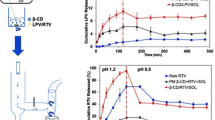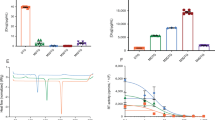Abstract
Background: Liquid formulations are usually regarded as the gold standard in paediatric formulation; but sometimes, liquid formulations have stability and taste problems as well as being inconvenient for travelling. Therefore, for the management of long-term illness, some older children, parents and clinicians would prefer to use solid formulations. However, there is a lack of studies to investigate the age at which children are converted from liquid to solid formulations.
Objectives: (1) To investigate the age range at which children convert from liquid antiretroviral drug formulations to solid formulations, the formulations are abacavir, didanosine, lamivudine, stavudine, and zidovudine. (2) To calculate how long children stay on each of five UK liquid formulations (retention time) and factors affecting the retention times of the above liquid formulations.
Method: This was a retrospective medical records survey at Great Ormond Street Hospital for Children, London, United Kingdom. Patients’ treatment details were entered into SPSS for Windows v. 11.0 and the retention times for the above liquid formulations were calculated i.e., from initiation of the liquid treatment to conversion to solid preparation. The retention times of different preparations were then compared using Cox regression analysis.
Results: A total of 92 patients are included in the analysis. The overall average age at conversion was 7.3 years (95% CI 6.3–8.2). Patients on stavudine were more likely to switch to the corresponding solid dose form than the other four medicines (P < 0.001); more than 50% of patients on stavudine switched to solid formulation after nine months of treatment, however, less than 25% of patients on other formulations switched during the same period.
Conclusion:Children taking antiretroviral liquid preparations change to solid dose forms at approximately seven years of age. However, for stavudine, children are more likely to take the solid form at an earlier age.
Similar content being viewed by others
References
E Schirm H Tobi TW Vries Particlede I Choonara LT De Jong-van den Berg (2003) ArticleTitleLack of appropriate formulations of medicines for children in the community Acta Paediatr 92 1486–9 Occurrence Handle14971804 Occurrence Handle1:STN:280:DC%2BD2c%2Fot1amtg%3D%3D
AJ Num (2003) ArticleTitleMaking medicines that children can take Arch Dis Child 88 369–71
S Conroy (2002) ArticleTitleUnlicensed and off-label drug use: issues and recommendations Paediatr Drugs 4 353–9 Occurrence Handle12038871
Prescribing for children. Merec Bulletin 2000; 11: 5–8 (www.npc.co.uk/MeReC_Bulletins/2000Volumes/pdfs/vol11n02.pdf).
AD Dajani (1996) ArticleTitleAdherence to physicians’ instructions as a factor in managing streptococcal phargngitis Pediatrics 97 976–81 Occurrence Handle8637785 Occurrence Handle1:STN:280:BymB3sjpvFE%3D
DM Matsui (1997) ArticleTitleDrug compliance in pediatrics: clinical and research issues Pediatr Clin North Am 44 1–14 Occurrence Handle10.1016/S0031-3955(05)70459-4 Occurrence Handle9057780 Occurrence Handle1:STN:280:ByiB3M%2FntFI%3D
N Blanchard J Primovic RD Leff (1999) ArticleTitleCompliance with pediatric medications J Paediatr Pharm Prac 4 181–5
MJ Fotheringham MG Sawyer (1995) ArticleTitleAdherence to recommended medical regimens in childhood and adolescence J Paediatr Child Health 31 72–8 Occurrence Handle7794628 Occurrence Handle1:STN:280:ByqA3MvovVc%3D
A Hazzard SJ Hitchinson N Krawiecki (1990) ArticleTitleFactors related to adherence to medication regimens in pediatric seizure patients J Pediatr Psychol 15 543–5 Occurrence Handle2124261 Occurrence Handle1:STN:280:By6D2sbpslQ%3D
PL Sharma V Nurpeisov B Hernandez-Santiago T Beltran RF Schinazi (2004) ArticleTitleNucleoside inhibitors of human immunodeficiency virus type 1 reverse transcriptase Curr Top Med Chem 4 895–919 Occurrence Handle10.2174/1568026043388484 Occurrence Handle15134548 Occurrence Handle1:CAS:528:DC%2BD2cXjslGhtLw%3D
DR Cox (1972) ArticleTitleRegression models and life tables J R Stat Soc 34 187–202
ICK Wong GE Mawer JWAS Sander SD Lhatoo (2001) ArticleTitleA pharmacoepidemiological study of factors influencing the outcome of treatment with lamotrigine in chronic epilepsy Epilepsia 42 IssueID10 1354–8 Occurrence Handle10.1046/j.1528-1157.2001.02101.x Occurrence Handle11737172 Occurrence Handle1:CAS:528:DC%2BD38Xht1Oqu7o%3D
SD Lhatoo ICK Wong G Polizzi JWAS Sander (2000) ArticleTitleLong-term retention rates of lamotrigine, gabapentin and topiramate in chronic epilepsy Epilepsia 41 IssueID12 1592–6 Occurrence Handle11114218 Occurrence Handle1:CAS:528:DC%2BD3MXjsFShtQ%3D%3D
SD Lhatoo ICK Wong JWAS Sander (2000) ArticleTitlePrognostic factors for long-term retention of topiramate Epilepsia 41 IssueID3 338–41 Occurrence Handle10.1111/j.1528-1157.2000.tb00165.x Occurrence Handle10714407 Occurrence Handle1:CAS:528:DC%2BD3cXitFCgs74%3D
ICK Wong D Chadwick PBC Fenwick GE Mawer JWAS Sander (1999) ArticleTitleThe long-term use of gabapentin, lamotrigine and vigabatrin in patients with chronic epilepsy Epilepsia 40 IssueID10 1439–45 Occurrence Handle10.1111/j.1528-1157.1999.tb02017.x Occurrence Handle10528941 Occurrence Handle1:CAS:528:DyaK1MXmvV2jtbs%3D
LM Dahlquist RL Blount (1984) ArticleTitleTeaching a six-year-old girl to swallow pills J Behav Ther Exp Psychiatry 15 171–3 Occurrence Handle6480873 Occurrence Handle1:STN:280:BiqD3cjlt1E%3D
RL Babbitt JM Parrish PE Brierly MA Kohr (1991) ArticleTitleTeaching developmentally disabled children with chronic illness to swallow prescribed capsules J Dev Behav Pediatr 12 229–35 Occurrence Handle1939677 Occurrence Handle1:STN:280:By2D2c3nvFU%3D
Author information
Authors and Affiliations
Corresponding author
Rights and permissions
About this article
Cite this article
Yeung, V.W., Wong, I.C.K. When Do Children Convert from Liquid Antiretroviral to Solid Formulations?. Pharm World Sci 27, 399–402 (2005). https://doi.org/10.1007/s11096-005-7911-z
Issue Date:
DOI: https://doi.org/10.1007/s11096-005-7911-z




